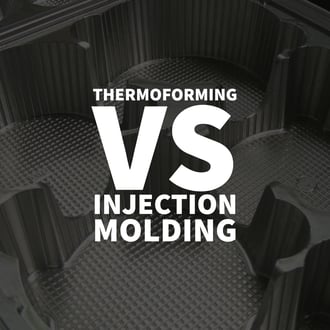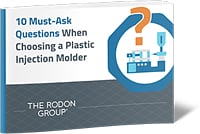Used in all types of industries, plastics provide versatility and strength across a wide range of applications, from automotive body parts to human body parts. Each application requires a unique manufacturing process that can mold the part based on specifications.
 Both thermoforming and injection molding—two of the most popular manufacturing processes for crafting plastic parts—offer unique advantages depending on the particular application. While thermoforming is commonly used for large-scale designs and shorter production runs, injection molding tends to be a better choice for small, intricate parts and large production runs.
Both thermoforming and injection molding—two of the most popular manufacturing processes for crafting plastic parts—offer unique advantages depending on the particular application. While thermoforming is commonly used for large-scale designs and shorter production runs, injection molding tends to be a better choice for small, intricate parts and large production runs.
What Is Thermoforming?
Thermoforming is the process of forming a heated plastic sheet to the surface of either a male or female mold. This is a single-sided plastic fabrication process, unlike injection molding; only one side of the plastic sheet is controlled by the mold or tool. Vacuum forming and pressure forming are both popular styles of thermoforming.
Depending on a project’s needs, thermoforming can offer several distinct advantages, including:
- Lower tooling costs compared to injection molding
- Quick product development and prototyping
- Bright color and texture options
- Extreme adaptability and simple adjustments
Thermoforming is ideal for smaller production quantities (250 to 3000 parts per year).
Lower Tooling Costs
Tooling for thermoforming is less expensive than injection molding. Molds for thermoforming are often made of inexpensive aluminum. In contrast, injection molds are typically composed of thicker aluminum, steel, or other heavier alloys to withstand higher pressures and enable continuous reuse over larger production runs. In addition, thermoforming uses only a single-sided tool rather than a double-sided injection mold. This results in virtually half the material usage for mold-making, which significantly reduces the up-front cost of thermoforming. However, the molds are less durable and cannot be used for large scale or repeat production.
The size of the component plays a significant role in thermoforming's cost-effectiveness compared with injection molding. The larger the component, the wider the gap between tooling costs. Thermoforming becomes increasingly cost-effective as the part increases in size.
Quick Product Development and Prototyping
Due to the speed with which thermoforming molds can be produced, thermoforming is much faster than injection molding when it comes to product development and prototype testing. Injection mold tooling is more time-consuming, as the molds are double-sided and composed of harder materials such as steel. Comparatively, thermoform molds are easier to design, fabricate, and modify, making them ideal for development and testing.
Versatile Texture and Bright Color Options
Thermoforming offers a variety of benefits for product design and branding. Bright colors can be incorporated into thermoformed plastics, facilitating vivid, durable coloring throughout the material. In addition, thermoform materials accept painting, silk screening, printing, stenciling, and coatings that provide unique designs, textures, and finishes to enhance the appearance and the longevity of the product.
Extreme Adaptability and Simple Adjustments
Since thermoforming uses a simple single-sided mold made from highly formable materials, thermoform designs can be modified quickly and with minimal cost. Injection molding, on the other hand, requires dual molds with heavier materials that are more time-consuming and expensive to tool.
Applications That Use Thermoformed Products
The lower costs, versatility, and adaptability of thermoforming make it ideal for many applications, including:
- Automotive: Dashboards, seat components, interior panels, bumpers, and air ducts
- Aerospace: Air ducts, seat components, interior panels, galley equipment, and window shades
- Construction: Equipment housings, tool cases, interior, and exterior panels
- Medical: Diagnostic and imaging equipment housings, bed and furniture components, assistive equipment, and wall and ceiling panels
- Public transportation: Interior and exterior vehicle panels, seat components, dashboards, and light fixtures
- Office equipment: Fax, printer, computer, and copier housings, electrical panels, wall and ceiling panels, and furniture
What Is Injection Molding?
-1.jpg?width=320&name=group%20(2)-1.jpg) Injection molding requires a great deal of upfront design and engineering to develop detailed tooling or molds. Crafted from stainless steel or aluminum, split-die molds are injected with molten liquid polymers at high temperatures under extreme pressure. The molds are then cooled to release complete plastic parts.
Injection molding requires a great deal of upfront design and engineering to develop detailed tooling or molds. Crafted from stainless steel or aluminum, split-die molds are injected with molten liquid polymers at high temperatures under extreme pressure. The molds are then cooled to release complete plastic parts.
Plastic injection molding offers several distinct advantages of its own, including:
- Detailed, highly engineered tooling with multi-cavity mold options
- Precise, efficient processing for large volumes of small parts
- Effective reduction of piece count
- Efficient material use and low scrap rates
Plastic injection molding is ideal for large-volume orders and mass production in projects requiring thousands or even millions of the same part.
Detailed Tooling for Complex Parts
One of the primary benefits of injection molding is the ability to create extraordinarily complex components with an exceptional degree of detail. The high pressure used in the injection molding process allows the production of intricate components and unusual geometries, as material is forced firmly into even the smallest detailed cavities. Multi-cavity mold options allow the injection molding process to be further tailored to meet specific needs.
Extreme Precision and Efficiency
Injection molding involves the use of durable and reusable molds for repeated runs. Users may rely upon the mold to provide highly accurate, repeatable results for large production runs over many years. The process is particularly useful for extremely small, complex, and intricate components that are time-consuming or difficult to create using thermoforming, cutting, milling, and other fabrication methods.
Plastic Injection Molding Cost Reduction
Although injection molding is more expensive than thermoforming, the mold design and manufacturing process may be modified in various ways to reduce overall production costs. Simplifying and streamlining the design can reduce some of the cost that goes into creating detailed molds. In addition, employing material reduction methods such as undercutting and coring, or simply modifying molds from a similar product may offer means to affordably meet the needs of a new project.
Efficient Material Use
Injection molding is a highly efficient process with extremely low scrap rates. The amount of material for each component is precisely measured to ensure that the mold is completely filled, ultimately generating little overflow or waste. An injection molded product can be molded to scale and requires little additional tooling after it is ejected from the mold.
Applications For Injection Molded Products
Applications that benefit from injection molding include:
- Construction: Hand tools, fasteners, door and window locks, joiners, and handles, and other building accessories
- Aerospace and automotive: Turbine blades and housings, lenses, panels, and gears
- Food and beverage: Food-grade plastic for conveyor, filtering, and processing systems; and food and beverage packaging
- Medical and pharmaceutical:Medical device components, diagnostic kits, X-ray components, and surgical prep kits
- Point-of-purchase: Retail display equipment, such as dividers, hooks, and product stops

10 Must-Ask Questions eBook
What you need to know before selecting a molder for your project
Download our eBook, “10 Must-Ask Questions When Choosing a Plastic Injection Molder.” Inside, we cover key questions like:
- Does the molder guarantee the molds for the life of a project?
- How many molding machines do they have and what are their capabilities?
- Is their pricing competitive, even when comparing with offshore molders?
Plastic Injection Molding With The Rodon Group
The Rodon Group is proud to be an industry-leading plastic injection molder. ISO 9001:2015-certified with a fully equipped, 125,000-square-foot manufacturing facility, we specialize in custom, high-volume injection molding projects.
From initial design, custom tooling, and mold building to value-added services and just-in-time shipping, our complete turnkey services ensure that you receive the highest quality services for the best possible price.
To learn more about high-volume plastic injection molding and how it can benefit your next project, download our free eBook, “An Introduction to Plastic Injection Molding.”









Comments